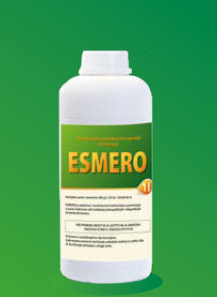Product information "ESMERO"
Selective systemic foliar and soil herbicide that
applied to control annual broad-leaved and some
of narrow-leaved weeds in the corn crop for grain and silage.
Active substance: mesotrione.......... 480 g/l
Formulation: concentrated suspension (SC)
Mode of action:
- It is absorbed through leaves and roots
- Mesotrione prevents the synthesis of carotenoids, which is reflected in "bleaching."
effect" ie in complete bleaching of the leaves.
- Weeds die about 2 weeks after foliar application and code
soil applications, weeds die in the budding phase.
Application:
It is used in mercantile and silage corn crops
- After sowing and before emergence of corn and weeds in a dose of 0.25 - 0.3 l/ha
- After the emergence of corn and weeds, when the corn has 2-9 leaves
and weeds in the stage of 2-8 leaves in a dose of 0.15-0.25 l/ha.
Water consumption: 200-300 liters of water per hectare.
Spectrum of action: broad-leaved weeds and side effect on
narrow-leaved (grass) weeds
- Weed species that it controls well: abutilon (Abutilon theophrasti),
ragweed (ambrosia artemisiifolia), tatula (Datura stramonium),
thistle (Xanthium strumarium), mustard (Sinapis arvensis), common
Chimney (Fumaria officinalis), common conica (Galinsoga parviflora),
loboda (Chenopodium spp.), common sedge (Senecio vulgaris),
knotted stink bug (Galeopsis tetrahit), wild radish (Raphanus
raphanistrum), I will-I won't (Capsella bursa-pastoris), gardeners
(Polygonum spp.), often nightshade (Veronica
persicaria), tanner (Rumex spp.), assistant (Solanum nigrum), dead nettle (Lamium spp.),
honeysuckle (Stellaria media), vetch (Vicia spp.), galium (Galium aparinae), ash (Atriplex
spp.), Amaranth (Amaranthus spp.),...
- Weed species (side-leaved weeds) on which it has a side effect:
bone (Echinochloa crus-galli), magpies (Digitaria sanguinalis), gray fly (Setaria glauca).
Crop rotation:
- if the treated areas are plowed, only corn can be sown immediately.
- In the autumn of the same year, small grains and oilseeds can be sown on the treated areas without restrictions
canola with previous plowing
- In the spring of the following year, corn can be sown on the treated areas, after deep plowing,
small grains, soybeans, sunflowers and potatoes.
- Sugar and fodder beets, spinach, peas and beans can be sown two years after applying the product
for plant protection.
Mixing with other preparations:
- Can be mixed with preparations based on nicosulfuron (Nicon 4 SC), rimsulfuron (Tiger 25
WG), terbuthylazine (TERAZOR 50 SC) s-metolachlor (VAZAL) – Do not mix
with insecticides strongly acidic reaction.
Maximum number of treatments on the same surface during the year: twice
Withdrawal period: provided by the time of application
Toxicity: III group of poisons
Packaging: 0.25 liters
Login


